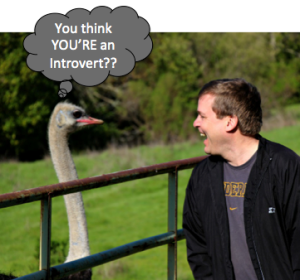December 13, 2011
by Steve Woodruff
 Tonight, on LeadershipChat, we welcome Brian Solis, author of multiple books (including his latest, The End of Business as Usual). We’ll be covering some themes from that book, including the idea of an adaptive organization.
Tonight, on LeadershipChat, we welcome Brian Solis, author of multiple books (including his latest, The End of Business as Usual). We’ll be covering some themes from that book, including the idea of an adaptive organization.
While you’re gearing your mind up for the chat, be sure to read my talented and lovely co-host Lisa Petrilli‘s blog post (The End of Business Leadership as Usual).
Brian is clearly a smart guy, and a very effective presence in social networks. And if you want to gain a clear statement of how businesses must go beyond business as usual, here’s a juicy passage (p. 13):
 In other words – connected consumers are now driving the revolution. Adapt or die.
In other words – connected consumers are now driving the revolution. Adapt or die.
But Mr. Solis also tends to make my head swirl, as I’ve read his writings over the years. Why? Well, I’m kind of a practical, plain-spoken guy. Brian’s thought process tends to be at another plane – shall we call it the Solisphere? – and his loquacious use of industry jargon is unparalleled. What do I mean? Well, here’s an extract from the book (p. 34):

Whew! With language like that, my guess is that this book will likely find its biggest appeal among the digerati – although the concepts are important for everyone in business.
As a fun experiment, I decided I would go through each chapter, and seek to extract one (or two) pinnacle statements that summarize the thought of that section – then string them together into a brief narrative and see if it presents an accurate overview of the main themes of the book (in Brian’s own words). Here goes:
– This book will introduce you to the connected consumer, and how they search for, discover, and share information, and ultimately, make decisions. In many significant ways, they’re not at all the consumer you know (Introduction)
– How people are connecting is setting the foundation for a powerful distribution network that rivals the greatest of news and broadcast networks (chapter 1)
– The democratization of information is connecting everyone, not just Millennials, distributing influence and making the role of the consumer and its impact on business more important than ever before (chapter 2)
– The medium is no longer just the message. Now, the medium is the platform and people now represent both the medium and the message (chapter 3)
– Researchers believe that the lure of social networks and the gadgets that link us to one another are rewiring our brains to constantly switch tasks. In the process, we lose our ability to preserve attention and focus (chapter 4)
– Businesses and media networks looking to attract connected consumers must earn every click by providing contextually relevant information and deliberate value. This changes the game for content production and engagement strategies (chapter 5)
– Many early adopters are betting on the importance of the connected consumer, investing in the cultivation of communities in areas where they don’t necessarily control, but as participants earn the privilege to steer experiences and interaction (chapter 6)
– At the center of the transformation of the audience is the ability for individuals to capture a moment through text, video, audio, or still images and share them in real time to the hundreds or thousands of individuals in their social and interest graphs…this is the dawn of an audience with an audience with audiences (my favorite expression in the book – SW) (chapter 7)
– On the train to enlightenment, an important stop is at the convergence of media and human networks…TV is a shared experience and the Web is often a personal activity that connects people through shared experiences (chapter 8 )
– By understanding the dynamics of social capital and its relationship to influence, organizations learn how to identify connected individuals who reach ideal communities and offer the ability to amplify reach, build relationships, and drive beneficial outcomes (chapter 9)
– Reviews and experiences from trusted peers, experts, and influencers form the foundation of the network. The information that flows into the stream from multiple networks sparks conversation and triggers clicks, while shaping perception and steering decisions in the process. Social customers are highly connected and trust networks are affecting outcomes with or without the businesses the affect (chapter 10)
– Connected consumers purchase in public, and as such, they influence the decisions of others through the public stream (chapter 11)
– Retailers are bringing experiences to the connected consumer from virtual dressing rooms to cash registers, letting them shop, share, and pay on their own terms (chapter 12)
– In these interactive online colonies, brands are not only created, brand stature and strength are co-created. The new social landscape is rich with emotion (chapter 13)
– The decision-making cycle is evolving away from a linear process to an elliptical cycle that publicizes touchpoints for brand connection (chapter 14)
– Connected customers are not cogs in the business machine, but they play an instrumental role in the progress of progress, the adaptation of business, and as such, become part of a new era of customer-centric business mechanics…the roles of the social consumer require different aspects of recognition and engagement and will eventually demand the complete socialization of your business (chapter 15)
– The adaptive business will weave customers into its culture, development, process, and story…businesses must design products and services that create meaningful and shareable experiences (chapter 16)
– Customer-centricity begins with a culture of change…introducing purpose into the business model and operating under a veil of transparency, customers and businesses collaborate in something bigger than they are (chapter 17)
– Control was never there, however – at best, businesses possessed the semblance of control. In a connected global society, customers are in control of the brand experience and it didn’t take new media to bestow this power on them. That’s the gift of free thought. Opinions are universal, and now the ability to share them with the masses and affect the impressions and decisions of others is equally democratic (chapter 18)
– The future of business starts with change and ends with change management. Customers represent only one side of the equation, however, and for the adaptive business, engaged and empowered employees represent the balance (chapter 19)
– Becoming an adaptive business is not the final stage of evolution…the next level for companies is to become a predictive business. The essence of evolution and the ability to outpace digital Darwinism lie in the ability to embrace change and illustrate the attributes of those models that improve opportunities for relevance and leadership (chapter 20)
So – there’s a very condensed taste of how Brian sees the future. Every book tells a story. This is the story of how digital connections are changing business as usual. And what it may take to lead business in the midst of a revolution.
How do you see it? Is this just so much social network Kool-Aid, or a glimpse into a future moving inexorably upon and within us? Join us for a lively discussion on Twitter during #LeadershipChat tonight, December 13, at 8 pm ET.
——————
Hire Steve Woodruff if your identity and message need clarity (Brand Therapy)
Recent posts on Connection Agent:
>> Twitter Chats and Cocktail Parties
>> Finding Your DNA
Please feel free to subscribe to the Connection Agent blog via Reader (RSS) | via e-mail
Twitter: @swoodruff
 And I love it. Yeah, I said it. I love being an introvert.
And I love it. Yeah, I said it. I love being an introvert.






 However, in recent months, it has become clear to both of us that our professional lives are evolving in ways that make it impossible to continue hosting a weekly chat. Therefore, at the end of this month (May 2012), we’re going to wind down LeadershipChat. Lisa and I both began to wonder this year if LC had served its purpose. Over dinner in Chicago recently, we talked about how our decision to start up LC was conscious and purpose-full, and that at some point between, say, the next 8 minutes and 80 years, we were going to need to make a conscious decision about its continuance. Within 8 minutes of further discussion, we smiled knowingly at each other. It was time to retire LeadershipChat and move on to other endeavors.
However, in recent months, it has become clear to both of us that our professional lives are evolving in ways that make it impossible to continue hosting a weekly chat. Therefore, at the end of this month (May 2012), we’re going to wind down LeadershipChat. Lisa and I both began to wonder this year if LC had served its purpose. Over dinner in Chicago recently, we talked about how our decision to start up LC was conscious and purpose-full, and that at some point between, say, the next 8 minutes and 80 years, we were going to need to make a conscious decision about its continuance. Within 8 minutes of further discussion, we smiled knowingly at each other. It was time to retire LeadershipChat and move on to other endeavors.
























Recent Comments